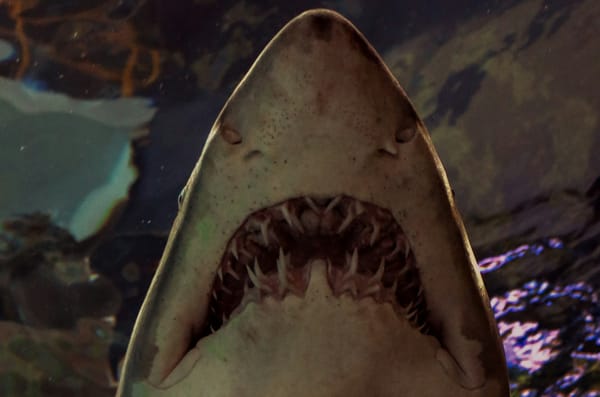The Frog Pond #10: A Medley of Mayhem
Or, 3 fun facts about poison, fennel and moonquakes.

It’s early. The birds are barely beginning to stir. Gray dawn light filters through the forest canopy. You have come to this Frog Pond for the last time. The winds have changed, the herds have migrated East, and you must move on from this small, sheltered forest. But first, you’re here to say goodbye.
This month’s Frog Pond is bittersweet, but for the best.
Mist-erious knowledge
A small package tied up in lily pads and cattails waits for you at the edge of the pond. You reach forward, but before you can open it something moves inside. More cautiously, you untie the package.
A small frog—the same one you saw last month?—stares up at you. It hops onto your hand and nods, as though asking to be carried upward. As you stand and bring it close to your face, the frog lets out a croak. A small trail of mist escapes its mouth and swirls around your face.
3 Fast Fun Facts
This month’s Frog Pond is a little different in format to accommodate my big move: Instead of one specific topic, I’m sharing 3 shorter fun facts I’ve come across in my research lately!
1: A conundrum of a carrot
Did you know that hemlock, a highly poisonous plant and invasive species, is part of the Apiaceae family, otherwise known as the “carrot” family? Hemlock also shares its family with anise, celery, coriander, cumin, dill, fennel, parsley, and other flowering biennial plants1.
Hemlock can be confused with wild carrots (also called Queen Anne’s lace—I’ve heard of that plant before but never knew it was a carrot!). How do you tell the difference? Wild carrots are characterized with hairy stems, no purple markings, and no clustered flowers. Hemlock has a smooth and purple-blotched stem, is a vivid green, and has large clumps of flowers2.
2: An extinct plant was well-loved, and the symbol of love itself?
Another member of the Apiaceae family was silphium, a well-document extinct plant from classical antiquity that was known as a seasoning, perfume, aphrodisiac, and medicine3. It was a costly plant with a hollow stalk and golden leaves4 that was used most famously as a contraceptive. But where is it now?
Prevailing theories label the ancient plant as a variant of giant fennel or another fennel species5, but nothing has been proven based on the lack of modern specimens to analyze. There’s plenty of records of the plant, especially on ancient coins across the Mediterranean, so we know it existed—just no physical evidence to test. The top theory for its extinction is overharvesting, either choking out its narrow native range or rendering the local soil unable to grow plants with the medicinal value they were primarily sought for, similar to how cultivated huckleberries grown from seed can’t bear fruit6.
One other fun theory around silphium is its connection to the modern symbol for a ❤️ heart. Silver coins from 6th-5th centuries BCE in Cyrene bear the heart symbol and the silphium plant together. Other plants in the Apiaceae family produce heart-shape schizocarp, a dried fruit7, strengthening the connection. Though some scholars have argued that the connection to love had more to do with silphium’s medicinal treatment for mental illness and the “madness” of love rather than love in the abstract8.
3: The liquid core and global magma ocean of the Moon
Did you know that the Moon has a liquid core, and once had a liquid surface? I always thought of the moon as basically a ginormous solid rock, but far from it! The Moon is a differentiated body9, meaning it has different chemical components at different layers of its body. From inside-out, the Moon has an iron core, a partially molten zone, a rocky mantle, and an “Earthside” and “Spaceside” crust10. The iron core contributes to its (albeit very weak - less than 1/100,000th of Earth’s) external magnetic field. The magnetic field was likely much stronger once, even comparable to Earth’s current field11. This was called the “lunar dynamo” and that’s rad.
The Moon’s internal structure is theorized as being created through “fractional crystallization” of a “global magma ocean” shortly after the Moon was formed 4.5 billion years ago12 from the collision of a Mars-sized body with the Earth. Basically: the Moon was coated in a layer of magma that created a thick ocean across its surface. The cooling of this ocean created the moon’s surface13. There’s still a mystery surrounding the crust—namely, why the gravitational field is bumpy/irregular. The large impact basins (those huge craters on the surface) have a big impact on spacecraft around the moon due to their dense “mare basaltic lava flows”. These lava flows by themselves don’t entire explain the differences in gravitational signature though, as some mass concentrations aren’t linked to the volcanos14.
Oh, that’s right—the Moon has volcanic activity! “Moonquakes” (!!) indicate that there was geological activity on the Moon as recently as 2 million years ago15. The impact basins are also called maria (from the Latin term for “seas”) and are nearly entirely on the near side, or Earth side, of the moon16. Within these maria, lava deposits either erupted or flowed into the depressions left by extra-lunar impacts. The maria may be more prevalent on “our” side of the Moon due to a much thicker crust on the “space” side, which may have happened due to “a slow-velocity impact of a second moon of Earth a few tens of millions of years after the Moon’s formation”17. Alternatively it might be a consequence of “tidal heating” back when the Moon was closer to Earth to create asymmetry18.
A word from a passing frog
By the time this email reaches you, I’ll have packed up, driven over 1,500 km back home to Atlantic Canada, and unpacked in my new place! I’m SO excited to start September off on the right foot and enjoy some well-earned down time for me and my SO.
Querying
Submitted: 138 (+8 since last month)
Rejections: 119 (+13 since last month)
Active Full Requests: 5 (+1 since last month)
Active Partial Requests: 2 (+2 since last month)
Not much to say - a few disappointments, a few exciting new possibilities, a lot of waiting.
Unfortunately, my application wasn’t successful for the Canada Council for the Arts grant I’d applied to back in the Spring. I’m not surprised or super let-down though, and I’m excited to re-apply with a new project for the next round!
Drafting
September is my big jump back into writing my sci-fi eco-horror novel, nicknamed TIE!
I have a plan with daily and monthly word count goals, but the basics are: I’m taking the entire month of September off from work, so I have 5 days a week starting September 5th to dedicate to writing. I’m so excited! And desperate to not psych myself out! So I hope to report back in October with great progress :)
Reading
I read 4 books last month, but only finished 2:
Sea of Tranquility by Emily St. John Mandel: I read this short sci-fi book over two very far apart stretches of time (library loans) and that’s oddly fitting for a book about time travel. It’s also about plagues, human connection, and the every day changes that huge societal-level havoc causes on normal people. I really enjoyed the weaving stories and narrative voice(s), but sometimes it was hard to listen to the plague details (though not the fault of the author!).
Emily Wilde’s Encyclopaedia of Faeries by Heather Fawcett: A really phenomenal fantasy romance featuring a prickly professor searching for her encyclopaedia’s next subject (a hidden species of faeries outside a remote town), and the man who’s come along from their institution to bother her—or has he? The book has a ton of fun lore about faeries and a surprisingly dark side for a fantasy romance. I highly recommend, especially for the character voice and world building!
The mist leaves your vision and is snatched out of the air by the small frog’s tongue. But the frog doesn’t hop away. It sits in your palm, its wide mouth almost seeming to smile.
It hits you; the Frog Pond is coming with you. Not the water or the reeds, not the ducks or the meadow grass, but the soul of its very nature. This little frog, and its strange knowledge, will follow.
You head back to the emptying cottage, frog on your shoulder. There are responsibilities and joys to get on with. Boxes to pack, wagons to fill, and words to write. The world keeps moving, even if the frog pond stays quiet, strange, and weirdly wonderful.
But maybe you’ll find a new pond, at the next home you find yourself in.
Footnotes
1
2
https://ravensroots.org/blog/2015/6/26/poison-hemlock-id
3
https://www.bbc.com/future/article/20170907-the-mystery-of-the-lost-roman-herb
4
https://www.bbc.com/future/article/20170907-the-mystery-of-the-lost-roman-herb
5
https://www.ncbi.nlm.nih.gov/pmc/articles/PMC7825337/
6
https://www.bbc.com/future/article/20170907-the-mystery-of-the-lost-roman-herb
7
https://www.penn.museum/sites/expedition/the-coins-and-the-cult/
8
https://www.jstor.org/stable/293237?origin=crossref
9
https://link.springer.com/referenceworkentry/10.1007/978-3-642-27833-4_430-2
10
https://en.wikipedia.org/wiki/File:Return_of_the_moon_diagram.svg
11
https://www.ncbi.nlm.nih.gov/pmc/articles/PMC6938704/
12
https://ui.adsabs.harvard.edu/abs/2009NatGe...2..133N/abstract
13
https://ui.adsabs.harvard.edu/abs/2009NatGe...2..133N/abstract
14
https://web.archive.org/web/20041113045200/http://techreports.jpl.nasa.gov/2000/00-1301.pdf
15
https://books.google.ca/books?id=TWtLIOlPwS4C&redir_esc=y
16
https://www.science.org/content/article/long-live-moon
17
https://www.nature.com/articles/news.2011.456#B1
18





